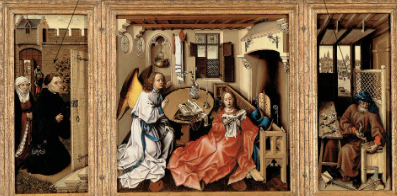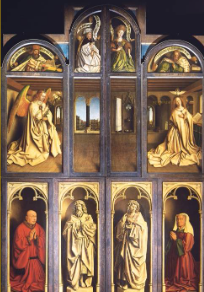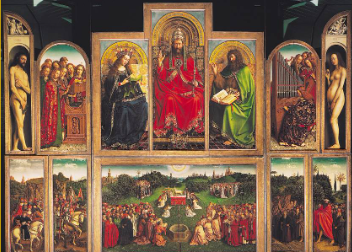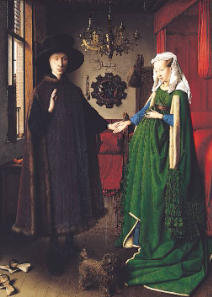The Early Renaissance in Northern Europe
1/3
There's no tags or description
Looks like no tags are added yet.
Name | Mastery | Learn | Test | Matching | Spaced |
|---|
No study sessions yet.
4 Terms

Mérode Altarpiece (Triptych of the Annunciation)
D: 1425-28
P/S: Northern Renaissance, international Gothic
A: Robert Campin M/T: oil on wood panel F: Religious Narrative of Jesus and Mary C: could symbolize Mary’s virginity and her purity as part of the Christian culture. It uses 3 panels, the middle being the largest and the two winds on either side, smaller and uniform. Natural and supernatural light is used, the mousetrap symbolizes the idea that Christ is bait.

Ghent Altarpiece (closed), Annunciation with Donors
D: 1432
P/S: Northern Renaissance
A: Jan and Hubert van Eyck M/T: oil on panel F: Religious narrative, recording history C: He and his brothers could be the creators of oil painting, polyptych piece, St John the Baptist on this piece, St John the Evangelist is depicted too.

Ghent Altarpiece (open), Adoration of the Mystic Lamb
D: 1432 ce
P/S: Northern Renaissancece
A: Jan and Hubert van Eyck M/T: oil on wood panel F: Religious narrative C: He and his brothers could be the creators of the oil painting, polyptych piece, with the Virgin Mary and God on the right, the adoration of the mystic lamb, believed to represent Jesus, surrounded by angles burning incense. Painted in a way to depict the lamb as Jesus but painted over because it was taken as unsettling. Adam and Eve, on the other side of the panel, only ones painted nude.

The Arnolfini Wedding Portrait
D: 1434 ce
P/S: Northern Renaissance
A: Jan van Eyck M/T: oil on wood panel F: Wedding Portrait, no true known meaning, maybe to show status or wealth C: The mirror represents the concept of God being all-seeing, housewives and fertility is symbolized through her green dress worn by the bride. Symbology was common during this period. The patron Saint of childbirth is included in ways, the candle being blown out shows the couple's relationship on their wedding night; an old tradition.